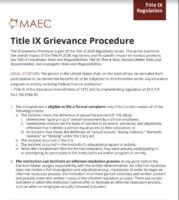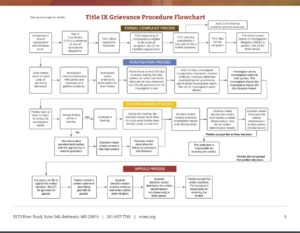
Download: MAEC_TitleIX_Grievance_Procedure_092120
Title IX Grievance Procedure is part of the Title IX 2020 Regulations series. This series examines the overall impact of the Title IX 2020 regulations and its specific impact on various positions. See other documents in the series:
- Title IX Coordinator Roles and Responsibilities
- Title IX Then and Now for K-12 – What has Changed?
- Title IX Investigator Roles and Responsibilities
- Title IX Decision-Maker Roles and Responsibilities
Title IX Grievance Procedure
LEGAL CITATION: “No person in the United States shall, on the basis of sex, be excluded from participation in, be denied the benefits of, or be subjected to discrimination under any education program or activity receiving Federal finance assistance.”
—Title IX of the Education Amendments of 1972 and its implementing regulation at 34 C.F.R. Part 106 (Title IX)
1. The Complainant is eligible to file a formal complaint only if the incident meets all of the following criteria:
a. The incident meets the definition of sexual harassment (§ 106.30(a)):
i. Unwelcome “quid pro quo” sexual harassment by a school employee;
ii. Unwelcome conduct on the basis of sex that is so severe, pervasive, and objectively offensive that it denies a person equal access to their education; or
iii. An incident that meets the definition of “sexual assault,” dating violence,” “domestic violence,” or “stalking” under the Clery Act.
b. The incident occurred in the U.S.
c. The incident occurred in the institution’s education program or activity.
d. When the Complainant filed the formal complaint, they were actively participating in, or attempting, to participate in the institution’s education program or activity.
2. The institution can facilitate an informal resolution process at any point before the Decision-Maker assigns responsibility with the written determination. An informal resolution does not involve a full investigation and adjudication (e.g., mediation). In order to begin an informal resolution process, the institution must have parties’ voluntary and written consent and provide them with written notice of the informal resolution process. There are certain scenarios in which the institution cannot offer or facilitate an informal resolution process, such as when an employee sexually harassed a student.
3. For more details, see “Investigator Roles and Responsibilities.” The Notice of Investigation/Allegation (NOIA) must include:
a. Details of the allegations
b. A statement that the Respondent is presumed “not responsible” for
the conduct until the Decision-Maker makes a determination
c. A statement that all parties are allowed to have an advisor.
4. For more details, see “Investigator Roles and Responsibilities.” The investigative report must include:
a. Identification of the grievance procedure steps taken
b. Description of witnesses interviewed and their final statements
c. Corroborative and contradictory evidence, as well as documentation of evidence
d. Summary, including the findings
5. For more details, see “Decision-Maker Roles and Responsibilities.” The written determination must include:
a. Identification of the sexual harassment allegations
b. A description of the grievance procedure steps taken
c. Findings and evidence that support the determination
d. Conclusions regarding the application of the recipient’s code of conduct to the facts
e. A statement of, and rationale for, the results for each allegation
f. Permissible grounds for appeal, as well as the school’s appeal procedures
6. For more details, see “Title IX: Then and Now.” Institutions may choose to identify further grounds for appeal. Below is an incomplete list of reasons that constitute grounds for appeal:
a. Procedural irregularity that affected the outcome
b. Newly discovered evidence that could affect the outcome
c. Title IX personnel had a conflict of interest or bias that affected the outcome

Download: Title-IX-Grievance Procedure Flowchart. Contact us if you need an accessible version of the flowchart above.
Adapted from the U.S. Department of Education Title IX Final Rule regulations.

